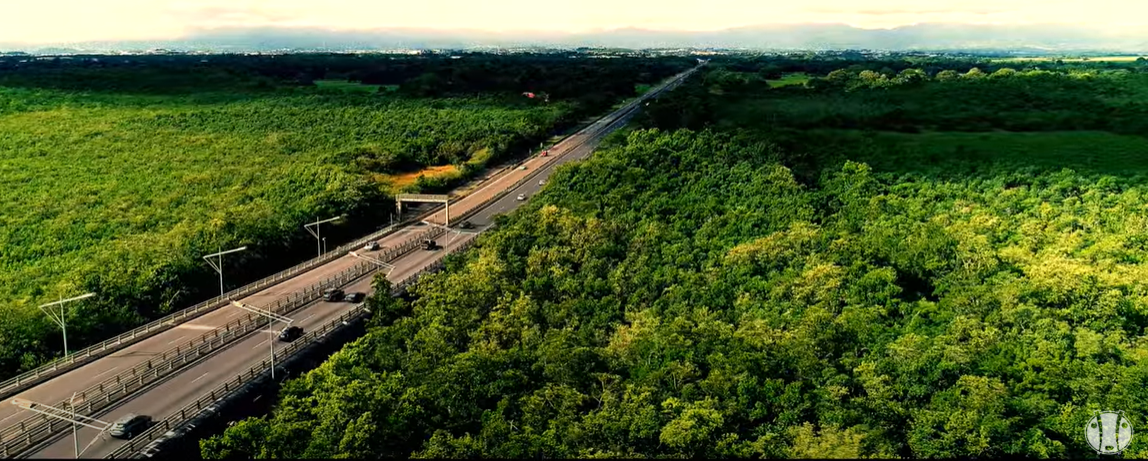"Kalbas Dyalèktik" by Mano D'iShango
In March 2020, Mano D’iShango released the music video of his 2017 track “Kalbas Dyalèktik”. The music video was directed by DanE Boy. You can read their interview here if you want to know more about the creating process. Now let me tell you why this music video is some kind of healing moment for me.
The “Kalbas Dyalèktik” music video is set in Guadeloupe. My initial reaction while watching this music video was between being fascinated and being intrigued. I was fascinated because the bright colors gave me the impression I was looking at a living painting. Especially the luminous green of the mangrove forest and the sugar cane sprouts. In the meantime, I was intrigued because the two main backdrops are places that have always given me anxiety : the “Alliance” Bridge and the sugar cane field. I had never managed to change my lens and see the beauty in these places.
Kalbas Dyalèktik screencap
Human being vs. Nature
The music video opens and closes with this overlooking view of the Alliance Bridge. I was about 10 when this bridge was inaugurated. I remember the stress I had whenever we had to go through it at first. From my point of view as a child, this bridge was gigantic and I was just scared it would collapse, no matter how strong it looked. Don’t ask me why I felt that way, I just did. This fear was even more irrational because we used the Gabarre bridge nearly on a daily basis and I was totally fine with it. Maybe I unconsciously wanted to hold onto the Gabarre bridge as a symbol of the history of Guadeloupe because it existed since the early 20th century and was based on an operating system during slavery days. However, watching the Alliance Bridge like a bird can see it, I saw the beauty and the elegance of its architecture in the mangrove. The glimpse of the port only adds to the reminder that human beings always transform their environment to survive and it is okay to let go of some vestiges from the past.
“Kalbas Dyalèktik” screencap
Nature vs. Human being
Whenever I see sugar canes fields, my brain automatically thinks about slaverism. I don’t see Nature. I just see an exploited space to give wealth to a certain group of people by killing another group of people. Films like “Sugar Cane Alley” (1983) by Euzhan Palcy or “Coco La Fleur Candidat” by Christian Lara (1979) and TV shows like British miniseries “The Long Song” (2018) helped turning this space into a visual reference about a past of suffering. In the meantime, I have a few music videos in mind in which sugar cane fields are just a simple backdrop. Sometimes, it’s a space of struggle like in “Trop peu de temps” by Nuttea, but it’s not always easily identified as you can see in “Zayann Business” by MC Kanis, “Gwada” by Dominik Coco, “An Tan La Sa” by Eric Dihal or “Viré” by Gilles Floro… But come to think of it, the beach is usually the go-to natural backdrop in music videos. Maybe it is time to reclaim the sugar cane fields too. Watching Black persons gracefully moving or just standing at peace in this space gave me somehow a sense of closure? Or more like it reminded me that our painful past came from other human beings and not from Nature itself.
Kalbas Dyalèktik screencap
The audio sequence toward the ending of the music video is an extract from the speech “Race conscience, class conscience, national conscience” by professor Henry Bernard*. In this speech recorded in 1970, he presents his philosophy as a world built on solidarity and with machines being at the service of human beings and not the other way around. Here we are 50 years later and we still have the same debate on how not to lose our humanity in the process of creating better and useful technology for everyone. In the end, I think the “Kalbas Dyalèktik” music video gives us an animated picture of Guadeloupe to showcase this forever changing link between human beings and Nature and lets us hear the importance of keeping the balance between these two forces.
Kalbas Dyalèktik screencap
* Professor Henry Bernard was an activist for Guadeloupean independence. He was in the ARC, an organization that led terrorist attacks for the independence in the 1980’s. The speech title in French is “Conscience de race, Conscience de classe, Conscience nationale”.



